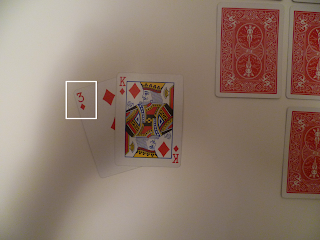If you haven't read parts
I or
II, none of these pictures will make sense.
Setup:
Separate the black and red cards.
Draw eight cards from each pile.
Shuffle these eight cards and lay out your battlefield.
Choose an origin point, x-axis, and y-axis for your battlefield. Here, the origin is the space outlined, the x-axis runs along the upper edge of the battlefield, and the y-axis runs down the left edge.
Each player draws one card from their deck and places it in their trenches. The areas representing the trenches are outlined.
First turn:
The black player moves his soldier from the trenches onto the battlefield.
The red player shuffles his soldier (3 of hearts) back into his deck and draws a new soldier. This new soldier gets placed in the trenches and can do nothing further this turn.
Artillery shells fall at the end of every turn. Two dice are rolled to determine where the shell lands on the battlefield. This two represents the x-coordinate.
This six represents the y-coordinate.
The space outlined here is where the shell lands. No able-bodied soldiers occupy that space, so the shell has no effect on gameplay. Currently, only one soldier occupies the battlefield, so only one shell falls. Four to five soldiers means two shells fall per turn. Six to seven means three shells fall per turn. And so on.
Second turn:
The black player picks up a wounded soldier with his seven of clubs and moves both of them back to his trenches. The wounded soldier turned out to be a six of hearts. Since the value of the wounded soldier (6) is less than or equal to the value of the soldier who did the rescuing (7) and the color of the wounded soldier is opposite that of the player, the rescued soldier gets placed in the infirmary. Soldiers in the infirmary count toward the player's total number of soldiers at the end of the game, but cannot be sent back onto the battlefield to help rescue other wounded soldiers.
The red player moves his soldier from the trenches onto the battlefield.
X-coordinate of shell.
Y-coordinate of shell.
No able-bodied soldiers occupy that space, so the shell has no effect on gameplay. Only one soldier occupies the battlefield, so only one shell falls.
Third turn:
The black player moves his soldier from the trenches onto the battlefield.
The red player picks up a wounded soldier with his king of diamonds and moves both of them back to his trenches. The wounded soldier turned out to be a three of diamonds. Since the value of the wounded soldier (3) is less than or equal to the value of the soldier who did the rescuing (K) and the color of the wounded soldier is the same as that of the player, the rescued soldier becomes able-bodied. This soldier can be sent out onto the battlefield to help rescue other wounded soldiers.
X-coordinate of shell.
Y-coordinate of shell.
I forgot to take a picture of the battlefield here, but no able-bodied soldiers occupy the space where the shell has fallen.
Fourth turn:
The black player picks up a wounded soldier with his seven of clubs and moves both of them back to his trenches. The wounded soldier turned out to be a jack of clubs. Since the value of the wounded soldier (J) is greater than the value of the soldier who did the rescuing (7) and the color of the wounded soldier is the same as that of the player, the rescued soldier gets shuffled back into the black players deck.
From last turn, the red player now has two able-bodied soldiers to move. For this turn, the red player stacks these two soldiers and moves them two spaces onto the battlefield. The more soldiers a player has in a stack, the greater the range of movement for those soldiers. Three soldiers in a stack means three spaces of movement for those soldiers. Four soldiers in a stack means four spaces of movement. And so on.
X-coordinate of shell.
Y-coordinate of shell.
No soldier is wounded by the shell.
Fifth turn:
The black player moves his soldier from the trenches onto the battlefield.
The red player picks up a wounded soldier and moves two spaces back to his trenches. The value of the wounded soldier (9) is less than or equal to the value of the highest-valued soldier who did the rescuing (K). The color of the wounded soldier is opposite that of the player, so the rescued soldier gets placed in the infirmary.
X-coordinate of shell.
Y-coordinate of shell.
No soldier is wounded by the shell.
Sixth turn:
The black player moves his soldier one space on the battlefield.
The red player moves both of his soldiers onto the battlefield.
X-coordinate.
Y-coordinate.
The red player's king of diamonds occupied the space where the shell hit. The king becomes a wounded soldier. This is signified by turning the king face down. Now, the red player cannot do anything with the king unless he carries him off the battlefield. It is also possible for the black player to carry this king off the battlefield.
I stopped taking pictures after this. I hope this makes the rules of play clearer. Maybe not. I tried.
Cheers,
Danny



































